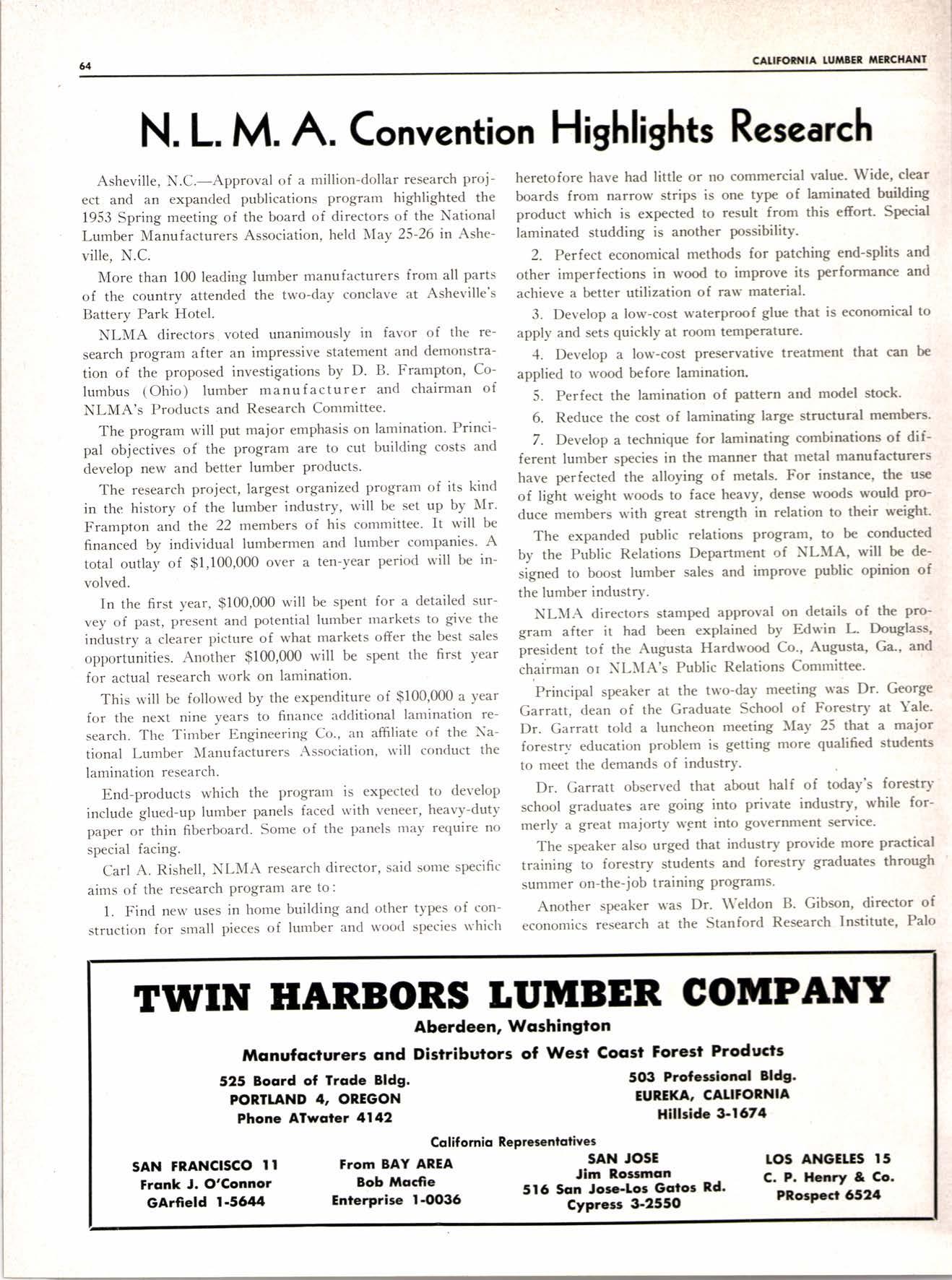
2 minute read
N. L. M. A. Convention Highlights Research
Asheville, N.C.-Approval of a million-dollar research project and an expandecl publications program highlighted the 1953 Spring meeting of the board of directors of the National Lumber Manufacturers Association, held NIay 2-t-26 in Asheville, N.C.
More than 100 leading lumber manufacturers from all parts of the country attended the two-day conclave at Asheville's Battery Park Hotel.
NLMA directors voted unanimously in favor of the research program after an impressive statement and demoustration of the proposed investigations by D. B. Frampton, Columbus (Ohio) lumber manufacturer and chairman of NLMA's Products and Research Committee.
The program will put major emphasis on lamination. Principal objectives of the program are to cut building costs and develop new and better lumber products.
The research project, largest organized program of its kind in the history of the lumber industry, rvill be set up by I\Ir' Frampton and the 22 members of his committee. It will be financed by individual lumbermen and lurnber companies. A total outlay of $1,100,000 over a ten-vear period rvill be involved.
In the first year, $100,000 will be spent for a detailed survey of past, present and potential lumber tnarkets to give the industry a clearer picture of u'hat markets offer the best sales opportunities. Anotl-rer $100,000 will be spent the first year for actual research work on lamination.
This will be followed by the expenditure of $100'000 a Year for the next nine years to fin:rnce adclitional lamination research. The Timber Engineering Co., an affiliate of the National Lumber \fanufacturers Association, u'ill concluct the lamination research.
End-products which the prograrn is expected to develop include glued-up lumber panels faced u'ith veneer' heavy-dutv paper or thin fiberboard. Some of the panels ttral' require no special facing.
Carl A. Rishell, NLMA research director, said some specific aims of the research Program are to: l. Find ne\\r uses in home building and otl.rer types of construction for small pieces of lurnber and n'ood species Nhich heretofore have had little or no commercial value- Wide, clear boards from narrow strips is one tyPe of laminated building product which is expected to result from this effort. Special laminated studding is another possibility.
2. Perfect economical methods for patching end-splits and other imperfections in wood to improve its performance and achieve a better utilization of rarv material.
3. Develop a low-cost waterproof glue that is economical to apply and sets quickly at room temperature.
+. Develop a low-cost preservative treatment that can be applied to u'ood before lamination.
5. Perfect the lamination of pattern and model stock.
6. Reduce the cost of laminating large structural members.
7. Develop a technique for laminating combinations of different lumber species in the manner that metal manufacturers have perfected the alloying of metals. For instance, the use of light u'eight w'oods to face heavy, dense woods would produce members u'ith great strength in relation to their weight' The expanded public relations program, to be conducted by the Public Relations Department of NL\IA, will be designed to boost lumber sales and improve public opinion of the lumber industry.
NLI,IA directors stamped approval on details of the program after it had been explained by Edu'in L- Douglass, pres.ident tof the Augusta Hardwood Co-, Augusta, Ga-, and chainnan or NLIIA's Public Relations Conrrnittee.
Principal speaker at the trvo-day meeting rvas Dr' George Garratt, dean of the Graduate School of Forestry at Yale' Dr. Garratt tolcl a luncheon meeting \Ia1' 25 that a major forestr..' education problem is getting more qualified students to meet the demands of industrY.
Dr. Garratt observed that about half of today's forestry' school graduates are going into private industry, while formerly a great majorty $'gnt into government sen'ice. The speaker also urged that industry provide more practical training to forestrv students and forestrl' graduates through summer on-the-job training programs.
Another speaker u'as Dr. \\'eldon B. Gibson, director of economics research at the Stanford Research Institute, Palo










